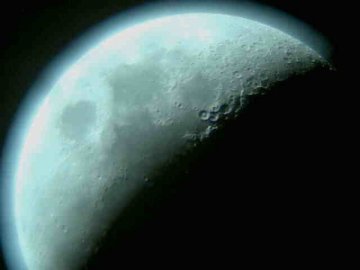 The space station is visible in the night sky this month. Would you like to see it? Sign up for SpaceWeather PHONE.
The space station is visible in the night sky this month. Would you like to see it? Sign up for SpaceWeather PHONE.
NEW HORIZONS: Pluto is a world of mystery. It has never been visited by any spacecraft. The best pictures of Pluto are blobby and indistinct. Astronomers can't even decide what Pluto is--a planet, a Kuiper Belt Object, an ice-dwarf? NASA's New Horizons spacecraft will reveal all when it reaches Pluto in 2015: full story.
LAUNCH UPDATE: For the second day in a row, the launch of New Horizons has been scrubbed, this time due to a power outage in Maryland at the John Hopkins Applied Physics Laboratory, which is managing operations of the spacecraft. Mission controllers will try again on Jan. 19th.
 SPACE STATION: Earlier this month, a bright light appeared over Stojnci, Slovenia, and moved slowly across the night sky. Amateur astronomer Marko Vidovic pointed his 8-inch telescope and saw a spaceship--the International Space Station (ISS).
SPACE STATION: Earlier this month, a bright light appeared over Stojnci, Slovenia, and moved slowly across the night sky. Amateur astronomer Marko Vidovic pointed his 8-inch telescope and saw a spaceship--the International Space Station (ISS).
"I took several pictures and combined them into this movie," says Vidovic. The station's solar arrays, habitats and laboratories are clearly visible. People often wonder if they can see such details through a telescope. Absolutely, yes. When it's directly overhead, the ISS appears to be about the same size as the planet Jupiter.
BLUE MOON ALERT: If you live in Alaska, be alert for blue moons this week. The Augustine Volcano located 185 miles from Anchorage is shooting plumes of ash 8+ miles into the air. Volcanic eruptions like this have been known to turn the moon blue. (continued below)

A blue moon, photographed in 2003 by Tom King of Watuga, TX: more.
People saw blue moons in 1983 after Mexico's El Chichon volcano erupted. And there are reports of blue moons caused by Mt. St. Helens in 1980 and Mount Pinatubo in 1991.
Ash is the reason. When bits of ash slightly wider than the wavelength of red light fill the air, red light is strongly scattered, while other colors pass. White moonbeams turn blue and even green.
Forest fires, sand storms and icy clouds can do the same thing. Contrary to popular belief, blue moons are real.

